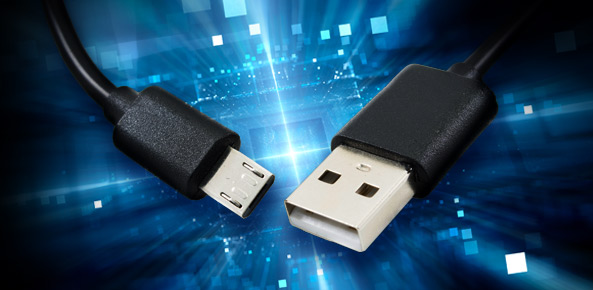The latest standard for USB connections will double data and power transfer speeds for new devices, while remaining compatible with older devices using earlier versions of the electronics connector system. By using multiple, rather than single, wire lane pairs in USB Type-C cables to transmit or receive data, the new standard will support operation speeds of up to 20 Gbps, an improvement over the 10 Gbps supported by the older USB 3.1 standard.
Announced yesterday by the USB 3.0 Promoter Group, the USB 3.2 specification is currently in a draft review stage. It is expected to be formally released to coincide with the USB Developer Days conference set to be held in late September in Vancouver, Canada.
Early details about the USB 3.2 specification are being released now to allow developers to begin designing USB Type-C cables and products that can support the new technology standard. More information and training will be provided for developers at the coming Vancouver event, according to the USB 3.0 Promoter Group, which develops standards for universal serial bus connectors.
‘Next Level of Performance’
“When we introduced USB Type-C to the market, we intended to assure that USB Type-C cables and connectors certified for SuperSpeed USB or SuperSpeed USB 10 Gbps would, as produced, support higher performance USB as newer generations of USB 3.0 were developed,” USB 3.0 Promoter Group chairman Brad Saunders said in a statement. “The USB 3.2 update delivers the next level of performance.”
To gain the full transfer speed improvements of the new standard, users will need a certified USB Type-C cable and a new USB 3.2 device that’s compatible with the updated specification, according to the statement. The update is part of the group’s ongoing USB performance roadmap.
“With increased performance and seamless compatibility, the new USB 3.2 specification brings even more speed and bandwidth benefits to new USB 3.2 devices, while remaining compatible with USB 3.0 and earlier devices,” said Roanne Sones, general manager of strategy and ecosystem for Microsoft’s Windows and devices division, in the statement. “We’re excited to work with our partners in the USB 3.0 Promoter Group to help showcase these benefits to users around the world.”
In addition to Microsoft, other members of the USB 3.0 Promoter Group include Apple, HP, Intel, Renesas Electronics, ST Microelectronics, and Texas Instruments. The group works to develop USB 3 standards to meet market needs.
Increasing Connector Speeds, Standardization
Introduced in 2014, the USB-C standard for universal serial bus connections is a more compact, easier-to-plug-in type of connector that supports faster charging and data transfers than older USB cables. Used with an adaptor, the USB-C standard can also support non-USB uses such as audio and Ethernet.
The more flexible USB-C connector is expected to see ever-wider use as the number and variety of electronic devices worldwide continue to grow. The analyst firm IHS forecasts that USB-C ports will be used for more than 2 billion devices by 2019.
While the USB 3.2 standard will support transfer speeds of up to 20 Gbps, the Thunderbolt USB-C connector specification first released by Intel and Apple in 2011 provides speeds of up to 40 Gbps and can support dual 4K displays and up to 100W of charging power. Intel announced in May that it expects nearly 150 new PCs and Macs will support its Thunderbolt 3 USB-C connector by the end of this year.
Source: USB 3.2 Aims To Double Data Transfer Speeds for New Devices | NewsFactor Network


